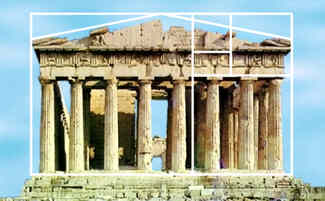I always recognized the role
mathematics plays in science, but I didn't really think about how mathematics
influences art. For some reason, I think of art as being creative and
spontaneous, while I think of math as being rigorous and structured. From the lecture
videos, though, I learned how techniques like perspective and the golden ratio
have been studied and applied to art to make artwork more aesthetically
pleasing (Vesna). One famous scientist, Abu Ali Al-hasan, studied the science
of vision and perspective, which Renaissance artists later used (Zahoor). Here is a sample of his work and his portrait (
The golden ratio can be seen in architecture, as shown in the Parthenon (Golden Ratio):
Not only is math applied to
two-dimensional art, it can also be applied to other art forms, like origami
and music. I thought it was really interesting that people have been coding
simulators to computationally determine ways to fold something along a line or
plane (Lang). Knowledge of algebra and geometry are especially useful
here. As for music, mathematics is used to encode sound, for which
knowledge of binary numbers and bitwise operations would be helpful, and
determine frequencies, for which calculus and trigonometry would come in handy
(Burk).
Math can be also applied to biology. Leonardo da Vinci, a famous scientist and artist, noted that parts of the human body are related by the golden ratio too (Parveen), (Golden Ratio in the Human Head):
From this week’s lessons, I
think artists actually use a lot more math than many would realize. For
example, artists analyze angles when they’re considering the viewers’ lines of
view and perspectives. However, I don’t see art being used as much in the
sciences, except in design in tech companies.
The juxtaposition of math,
art, and science highlights the need for math in both art and science.This is particularly
interesting to me because of the huge perceived contrast between math and art,
yet math informs a lot of the basic techniques in art. Math is definitely
necessary in science too, especially subjects like physics and chemistry, but I
don’t see as much of a contrast between the two.
Works Cited
Abu Ali Hasan Ibn Al-Haitham. Digital image. Nitum. N.p., 27 Sept. 2012. Web. 12 Apr. 2015.
Burk, Phil, Larry Polansky, Douglas Repetto, Mary
Roberts, and Dan Rockmore. "Music and Computers." Music and
Computers. Columbia University, n.d. Web. 13 Apr. 2015.
Golden Ratio. Digital image. Math Is Fun. N.p., n.d. Web. 12 Apr. 2015.
Golden Ratio in the Human Head. Digital image. MATHEMATICS AND ART. University of Georgia, n.d. Web. 12 Apr. 2015.
Lang, Robert J. "Computational
Origami." Computational Origami. Robert J. Lang Origami, n.d.
Web. 13 Apr. 2015.
Parveen, Nikhat. "MATHEMATICS AND ART." MATHEMATICS AND ART. University of Georgia, n.d. Web. 13 Apr. 2015.
Vesna, Victoria. Mathematics - Zero
Perspective Golden Mean. UCLA, 9 Apr. 2012. Web. 12 Apr. 2015.
Zahoor, A. "ALHAZEN (965-1040 AD)." ALHAZEN (965-1040 AD). University of California, Santa Barbara, n.d. Web. 13 Apr. 2015.


Like you, I've come to notice how there appears to be a sort of imbalance between the used of math/science in art compared to the other way around. Perhaps math not only serves as a basis in the sciences but also in the arts as well.
ReplyDelete